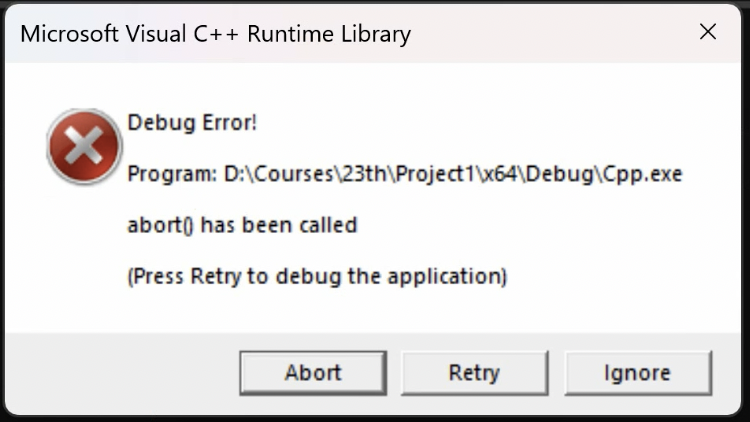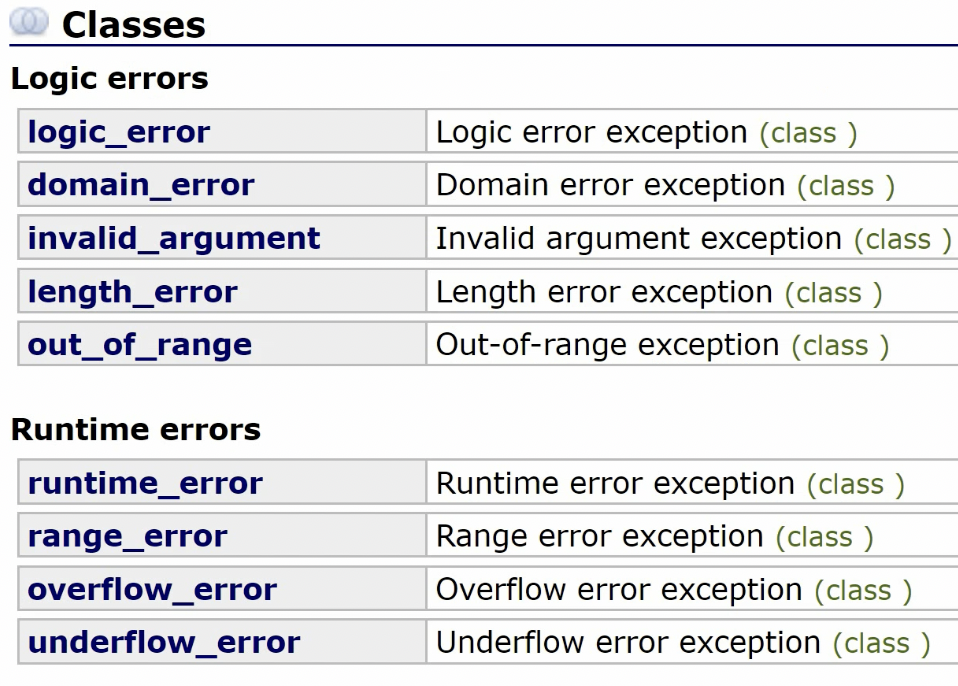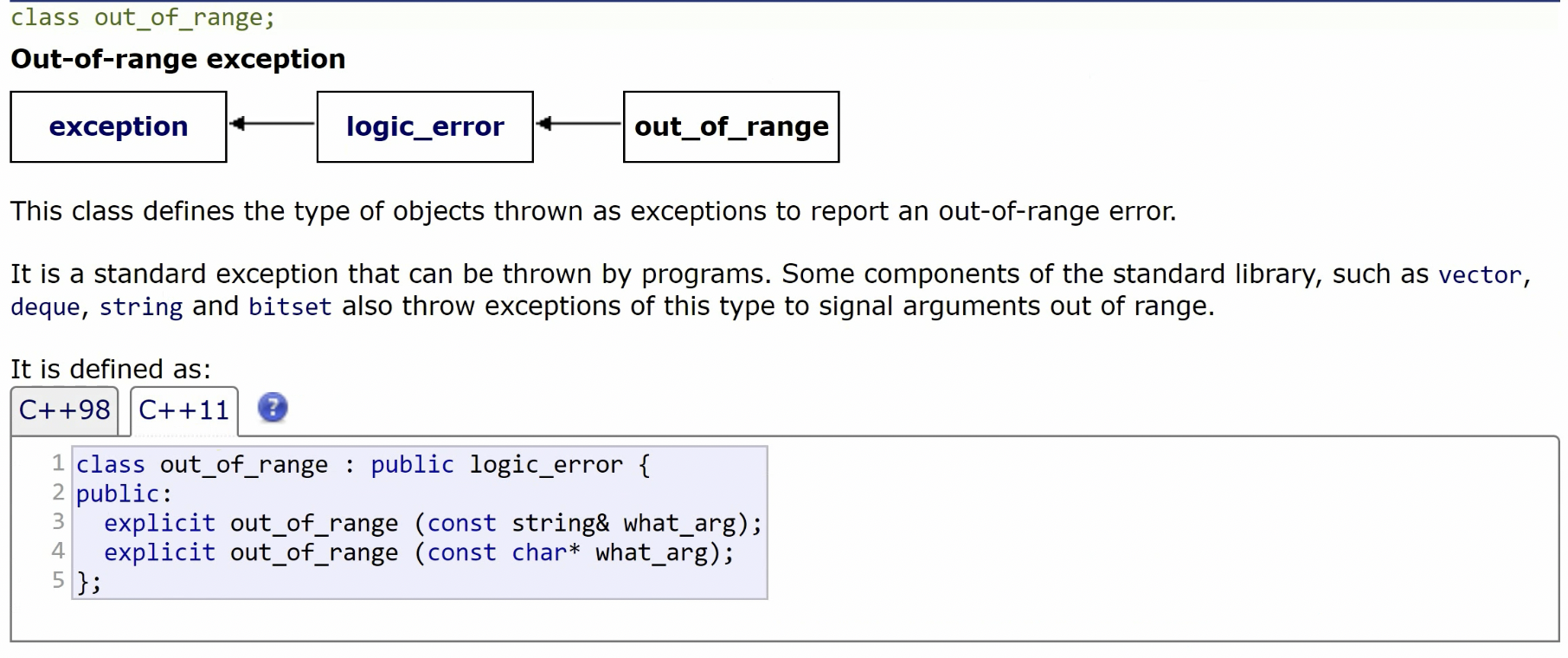C++异常处理机制
1
2
3
4
5
6
7
8
9
10
| int bar(int a, int b)
{
return a / b;
}
int main()
{
int result = 0;
result = bar(10, 0);
return 0;
}
|
以上会产生除0异常:

如果是Release的程序,不处理异常,就会造成闪退。
throw
throw可以是任何东西,一个对象,一个指针,一个值。
只要throw了,那么程序就会中断、跳转,如果有try-catch就走catch,如果没有则进行下一条语句。
1
2
3
4
5
6
7
| int bar(int a, int b)
{
if(b == 0)
{
throw e;
}
}
|
try-catch
类似于switch-case,但是case值不限制类型。可以通过catch(...)代表default。
1
2
3
4
5
6
7
8
9
10
11
12
13
14
15
16
17
18
19
20
21
22
| int main()
{
int result = 0;
try
{
result = bar(10, 0);
}
catch (const double& e)
{
std::cout << e << std::endl;
}
catch (const int& e)
{
std::cout << e << std::endl;
}
catch (...)
{
std::cout << "Unhandled Exception!" << std::endl;
}
std::cout << result << std::endl;
return 0;
}
|
noexcept关键字
声明该函数不抛出异常。
1
| int bar(int a, int b) noexcept;
|
但是一旦实际运行时抛出了异常,程序就会直接挂掉。

异常库<stdexcept>
该库下,有两类errors:
- Logic Errors
- Runtime Errors

std::exception
基本上所有的exception类都继承于std::exception。如out_of_range:

std::exception可以拿字符串构造,然后用what()方法打印这个异常信息。
1
2
3
4
5
6
7
8
9
| #include <exception>
std::exception bar_exception{ "bar exception!" };
int bar(int a, int b)
{
if(b == 0)
throw bar_exception;
return a / b;
}
|
1
2
3
4
5
6
7
8
9
10
11
12
13
14
15
16
17
18
19
| #include <exception>
int main()
{
int result = 0;
try
{
result = bar(10, 0);
}
catch (std::exception const& e)
{
std::cout << e.what() << std::endl;
}
catch (...)
{
std::cout << "Unhandled Exception!" << std::endl;
}
std::cout << result << std::endl;
return 0;
}
|
自定义exception
1
2
3
4
5
6
7
8
| class BarException : public std::exception
{
public:
char const* what() const override
{
return "bar exception!";
}
};
|
1
2
3
4
5
6
7
8
9
10
11
12
13
14
15
16
17
18
19
20
21
22
23
24
25
| #include <exception>
int bar(int a, int b)
{
if(b == 0)
throw BarException{};
return a / b;
}
int main()
{
int result = 0;
try
{
result = bar(10, 0);
}
catch (std::exception const& e)
{
std::cout << e.what() << std::endl;
}
catch (...)
{
std::cout << "Unhandled Exception!" << std::endl;
}
std::cout << result << std::endl;
return 0;
}
|
实例
异常用在什么地方呢?不能通过函数的返回值来判断正确与否的时候。如下:
string的at(抛异常,检查边界)
有两种:
-
at位置的字符不能修改
-
at位置的字符可以修改
-
可能会out of range。
-
返回的都是引用类型,引用不能为空,所以不能通过返回值是否为空来判断是否错误了,所以得用异常机制。
1
2
3
4
5
6
7
8
9
10
11
12
13
14
15
16
17
18
19
20
21
22
23
24
25
26
27
28
29
30
31
32
33
34
35
36
37
38
39
40
| #include<exception>
class OutOfRange : public std::exception
{
public:
OutOfRange() : std::exception{"MyString: out of range!"}
{
}
}
class MyString
{
public:
char & at(const size_t off)
{
size_t len = strlen(_str);
if(off > strlen - 1)
throw OutOfRange{};
return _str[off];
}
char const & at(const size_t off) const
{
size_t len = strlen(_str);
if(off > strlen - 1)
throw OutOfRange{};
return _str[off];
}
}
int main()
{
if(str)
{
try
{
std::cout << str.at(11) << std::endl;
}
catch (const std::exception &e)
{
std::cout << e.what() << std::endl;
}
}
}
|
string的[](不抛异常,不检查边界)
与at函数的不同在于,[]是不抛出异常的,因此不检查边界。如果越界,则行为未定义。
1
2
3
4
5
6
7
8
9
10
11
12
| class MyString
{
public:
char& operator[](const size_t off) noexcept
{
return _str[off];
}
char const & operator[](const size_t off) const noexcept
{
return _str[off];
}
}
|
总结
- 异常用在什么地方呢?不能通过函数的返回值来判断正确与否的时候。比如返回值是引用,引用没有空值。
- 如果函数在内部自己处理了异常,即不会抛出异常,那么最好声明为noexcept。代表别人调用此函数时,别人就不用try-catch了。



